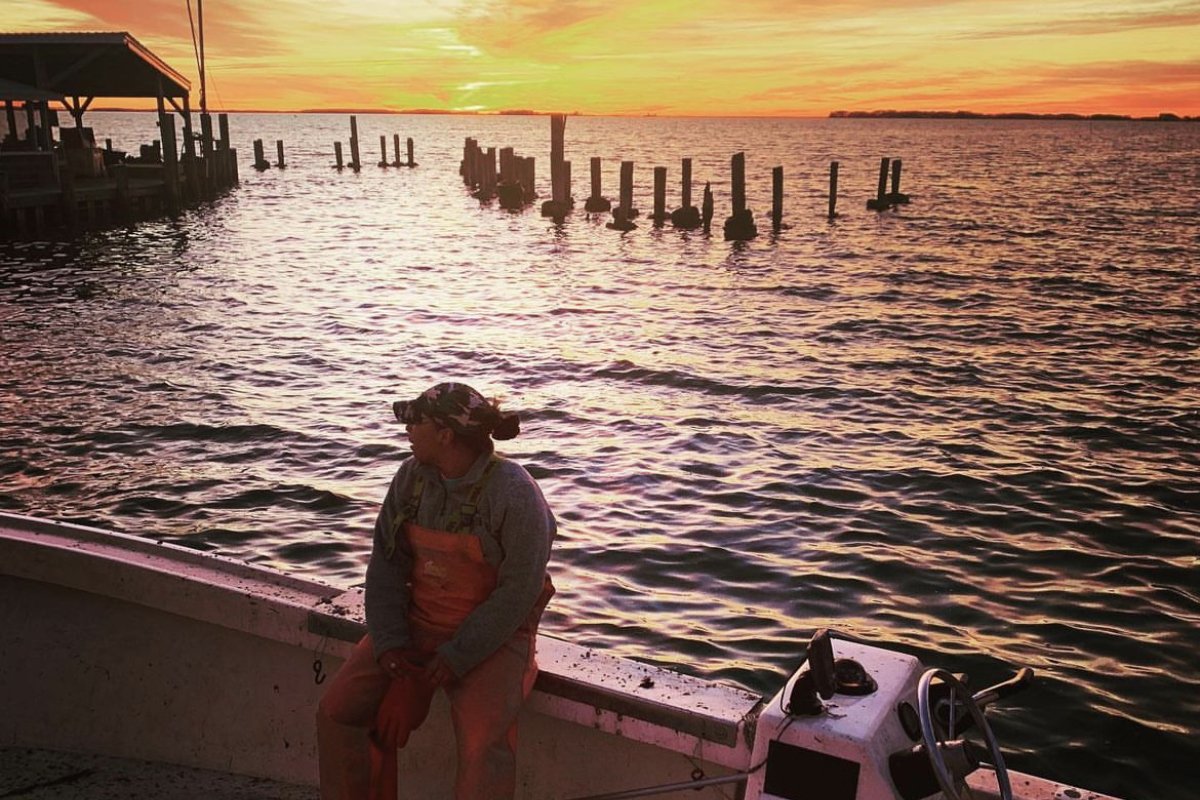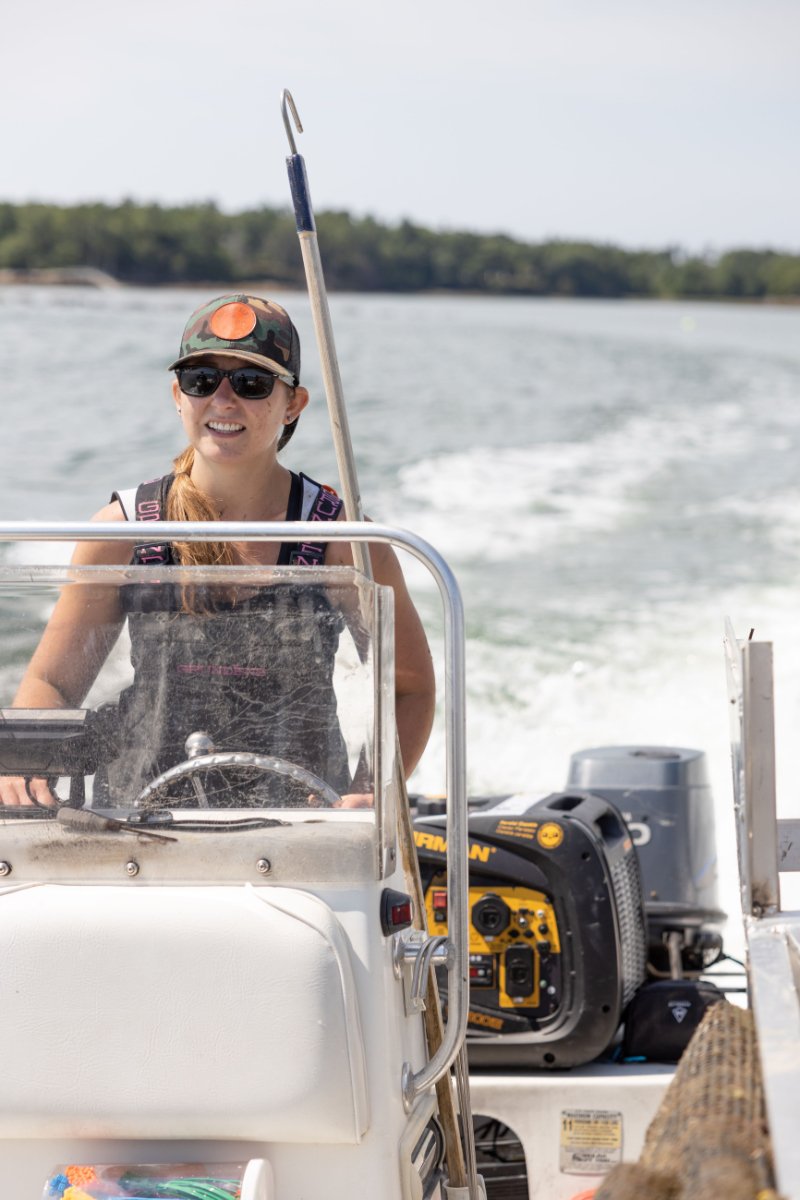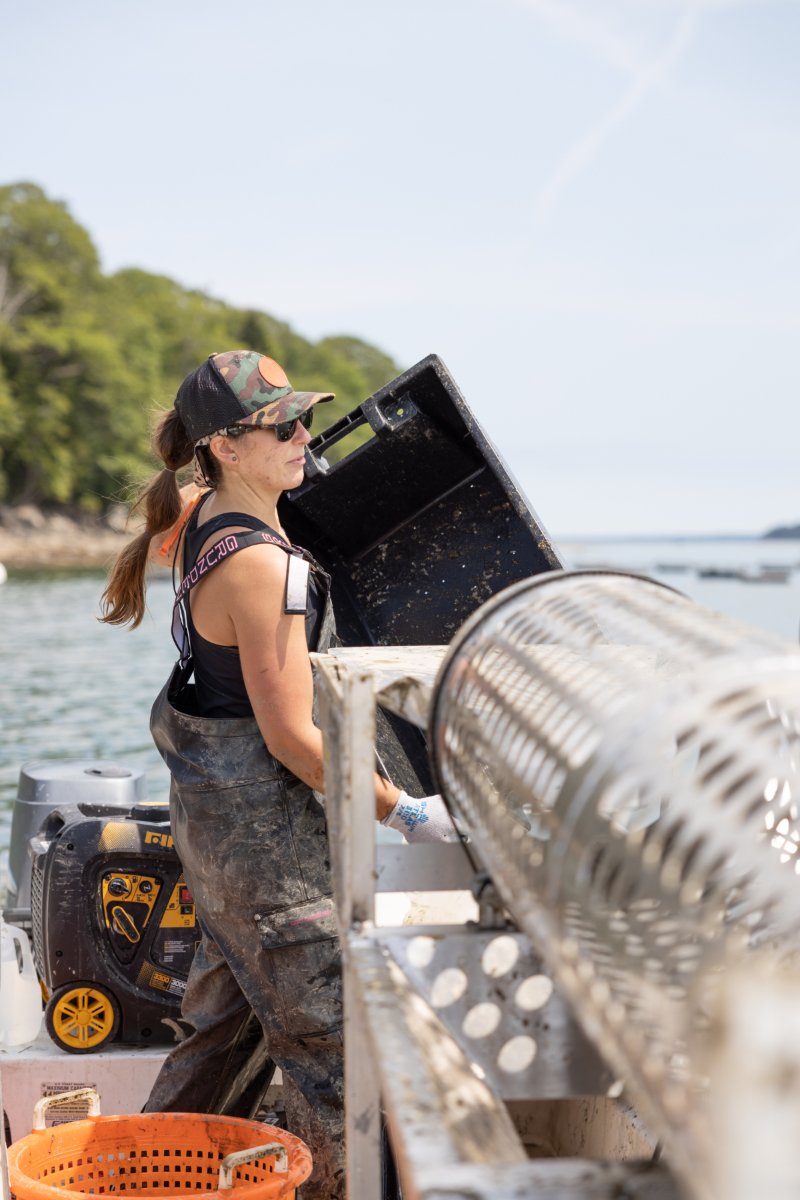Like farmers on land, beginning oyster farmers face steep obstacles shaped by pressures from development and land-use policies that put their access to the ocean at risk.

Like farmers on land, beginning oyster farmers face steep obstacles shaped by pressures from development and land-use policies that put their access to the ocean at risk.
April 3, 2023

Oyster farmer Imani Black sits on her boat at sunset. (Photo courtesy of Imani Black)
When she isn’t planting, maintaining, or harvesting oysters, Alicia Gaiero, owner of Nauti Sisters Sea Farm, works as a nanny for a family who lives on an island at the edge of Maine’s Casco Bay. But the side job has provided her with something just as valuable as an added income: a place to enter the bay and store her equipment.
“Meeting this family [has] changed my life,” said Gaiero. “I keep all of my equipment there, and I’m able to work [from] the island—where before I had to transport everything, every single day.”
Despite growing up in Maine, Gaiero did not come from a fishing family, nor did she grow up eating oysters. But once she tasted one while working as an intern with a salmon farm, Gaiero knew she wanted to work with them. She started Nauti Sisters in 2019 and currently farms 110,000 oysters per year, selling directly to restaurants in the Portland area, as well as some local wholesalers.

Alicia Gaiero piloting her boat on the way out to her oyster farm. (Photo credit: Justin Smulski, Tide to Pine)
Like many young people, though, she moves from apartment to apartment every few years, and finding a home with a place to store her boat and equipment—which includes bags, additional cages, and processing equipment, all of which can get quite smelly—posed a challenge.
“I can’t believe I thought I’d be successful without having waterfront access,” said Gaiero, who now also works as a consultant to help other young farmers start businesses. “It has been a really big deal to have water access.”
But Gaiero’s situation is uncommon. Much like young farmers on land, most young oyster farmers and others in aquaculture face serious challenges finding a place to farm. Even when they do, maintaining access can be an ongoing challenge. According to 2019 data from the University of Maine, for example, only 20 miles of Maine’s 5,300-mile coastline supports working-waterfront activities—which include spaces where people can bring a boat, offload and work on gear, and moor a vessel in safe waters—with all-tide access, connection to public roads, and parking. That number has decreased 20 percent since 2002.
“Private landowners basically see Maine as a cheap date compared to Boston, New York, or other very expensive places, so there’s a lot of pressure on families to sell their family docks.”
In Maine and along the Eastern coast, fishermen’s groups are working to protect and expand working waterfronts, with all the economic benefits they bring. Working waterfronts generate more than $740 million in revenue annually and support roughly 35,000 jobs for the state, according the University of Maine data. In addition to being a fast-growing seafood industry, oysters are a mainstay on restaurant menus, and some enterprising oyster farmers offer tourism packages for visitors.
Despite this value, many young people in aquaculture—as well as established aquaculture producers—are contending with pressures from development and land-use policies that put their access to the ocean at risk. Without that access, aquaculture farmers struggle to succeed—and some decide against entering the industry in the first place.
Threats to Working Waterfronts
A report from the Island Institute, a Maine-based nonprofit that supports the state’s coastal and island communities, cited factors such as a lack of financial support, dock maintenance, and affordable housing, as well as climate change as the biggest risks to Maine’s working waterfronts.
Among all these reasons, development pressure stands out as particularly challenging for young aquaculture farmers.
“The cost of taxes is super high, [and] there’s development pressure from people coming from outside wanting to buy up coastal properties and develop them into real estate investments,” said Afton Vigue, the outreach and development specialist for the Maine Aquaculture Association. “”Private landowners basically see Maine as a cheap date compared to Boston, New York, or other very expensive places, so there’s a lot of pressure on families to sell their family docks. That increased pressure to sell and a super competitive real estate market has made it harder for anyone who works on the water to be able to own a home on the water or even a home within reasonable driving distance of the ocean.”
In 2011, the U.S. Department of Commerce’s Economic Development Administration provided a grant to a number of nonprofits including Sea Grant programs in Maine, Florida, and Virginia with the goal of gathering information to preserve working waterfronts. But there has been little federal action.
And the Keep America’s Waterfronts Working Act, which would create a pilot for a loan fund for working waterfronts preservation, was last reintroduced in 2021 by Congresswoman Chellie Pingree (D-Maine) and Congressman Rob Wittman (R-Virginia), but it hasn’t passed.
Up and down the East Coast, as fishing has become less profitable, fish piers have been replaced with condos and fishing boats have been pushed out by yachts, according to Bob Rheault, the executive director of the East Coast Shellfish Growers Association.
“The issues of working waterfront access have been challenging watermen, fishermen, and [people working in] aquaculture for years and are continuing to worsen,” Rheault explained. “Even with the annual Working Waterfront Conference and federal legislation put in place to address the issue, little progress has actually been made.”
With the lack of federal action, a number of states, nonprofits, and individual oyster farmers up and down coast are looking at ways to protect the waterfront and make their businesses work.
Former oyster farmer Imani Black believes educating the surrounding community is essential to helping the aquaculture industry grow. The founder of Minorities in Aquaculture (MIA), Black worked at oyster farms in Maryland and Virginia year-round until 2020 when she stopped commercial farming to pursue a graduate degree and start MIA, which provides education about aquaculture and looks to increase the number of minorities in the industry.
“We live in a rural area, so there’s a ton of space to do things, but our access is limited when it comes to the waterfront,” said Black. While she has found that aquaculture farmers in the area don’t lack places to live or clean their equipment, she has noticed in recent years a growing tension between farmers and people moving in. In her experience, newcomers don’t often understand what an oyster farm is and don’t want one in their backyard.
“Like a lot of coastal communities, we’re trying to keep our traditional working waterfront mentality and our approach to the waterways,” said Black, “but as people move in and buy up land, we’re seeing those values change over time.” It’s part of a trend that’s pitting oyster farmers against neighbors around the United States.
The Chesapeake Bay’s 64,000-square-mile watershed covers parts of six states, though it’s hard to know exactly how much of that is working waterfront. Maryland, where Black is based, hasn’t evaluated its waterfront since the mid-2000s. At the time, that working waterfront commission identified the core challenge as a combination of declining profitability in the commercial fishing industry, rising real estate values, and a lack of communication among residents, fishermen, and policymakers about their shared concerns and the need for coastal waterfront access.
“We’re advocating for the traditional working waterfront by showing why it’s economically sound for coastal communities and how that goes also into restoration and commercial use. I think people are starting to see how having a working waterfront is really essential.”
In many marinas, even public ramp access is restricted to non-commercial use. According to Rheault, most boat ramps in the U.S. are built with federal Wallop-Breaux funds, which are intended to make recreational fishing and boat access easier. But, some states don’t allow commercial landings, fishing, or aquaculture at these facilities.
“I know of at least three growers on the East Coast who ended up buying marinas to retain access to their farms, and I don’t see this trend slowing down in 2023,” Rheault said.
While harbor ordinances and zoning protect some working waterfronts, as much as 60 percent of the access points in Maine are not officially zoned for commercial use. Instead, they are categorized as discrete working waterfronts, such as a private family dock that the owner has allowed oyster farmers and fishermen to access.
“We have tons of efforts in place to save these docks,” said Vigue. “The Working Waterfront Access Protection program is designed to put covenants on these properties and keep them commercial so that a new buyer would have to reserve it for commercial use.”
The program, which the state launched first as a pilot in 2005, provides funds to aquaculture farmers and fishermen with projects that will support commercial fishing activities and protect or establish working waterfront property. Created and funded by several community foundations in the region, the program spent roughly $6 million by 2020, and it planned to spend $4 million more between 2021 and 2025 . The funding has saved 27 working properties. But it’s not enough on its own, says Vigue.
“We can do everything in the world to save these docks, but if the businesses using them are not profitable and can’t afford to pay the rents, the docks won’t survive. So, it’s also about supporting the businesses.”
For some in aquaculture, buying land isn’t necessary, and many of Maine’s oyster farmers see co-ops as the best potential solution to the land access challenge. Keeping the business economically viable has meant oystering year-round for some. While that keeps farmers on the minds of the restaurant owners, it isn’t without challenges, which can be mitigated by cooperatives.
“The co-op structure enables the free flow of collaborative ideas and concepts amongst its members whilst creating community around a shared passion with a strong purpose,” said John Herrigel, a member of the New Meadows River Shellfish Cooperative, a group of Maine oyster farmers that came together to connect and share resources and equipment.
While the co-op considered using the pilot program to buy property, they ultimately withdrew their application. As many of the farmers live on the water, they’re able to grant access to anyone that doesn’t.

(Photo credit: Justin Smulski, Tide to Pine)
“We’re only two years old and decided it was too soon to buy a property, that even with the matching funds we would require a large loan,” Herrigel said. He added that they value the program and its purpose, but since they already share equipment and resources—including access to waterfront land—it wasn’t a good fit for them.
Fishermen who aren’t ready to buy land can turn to consultants like Gaiero to help them map out a strategy to get their business to a place where a commitment to land ownership makes sense. She starts with new farmers by asking if they have space at their home for equipment, whether they require storage for a boat and other equipment, if they require space closer to the water for day-to-day use, and other details.
“Then we dive into the local area and try to identify potential access points and [places] other members of the working waterfront might use,” Gaiero said.
As she moves into her third year of oyster farming, Gaiero is also now growing scallops and has hired an additional full-time employee and an intern through the Maine Career catalyst program.
“I’ve quadrupled in size since 2020,” Gaiero said. “We are bringing floating work space to the farm for our next phase of growth in 2023 and adding crucial equipment to the boat. To be successful in this industry it is all about scaling up and growing production, and this is absolutely something I’ve set my sights on.”

October 9, 2024
In this week’s Field Report, MAHA lands on Capitol Hill, climate-friendly farm funding, and more.
October 2, 2024

October 2, 2024

September 25, 2024

September 25, 2024

September 24, 2024

Like the story?
Join the conversation.